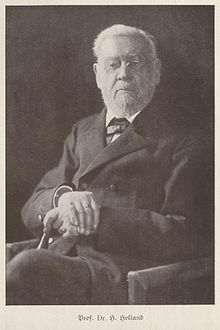Hyacinth Holland
Hyacinth Holland (born August 16, 1827 in Munich ; † January 16, 1918 there ) was a German art and literary historian.
Life
Holland was a son of the lawyer Christoph Holland and his wife Karoline Seel. In 1846 he passed the Abitur at the Wilhelmsgymnasium in Munich . Holland began studying Catholic theology at the university in his hometown, but later switched to law and medicine. He successfully completed his studies in art and literary history at the University of Würzburg in 1853 with his doctorate .
In 1853 Holland made his successful debut as a writer; he published the first volume of a history of German literature (laid out in three volumes, this work remained a fragment). He earned his living as a freelancer for various newspapers and magazines throughout his life. In addition, he already worked from time to time as a teacher; u. a. as tutor in the household of the Counts of Arco-Valley .
In 1865 Holland married the educator Maria Schmitt (1826–1905) in Munich. He got to know her at the Ascher educational institute , where he then held a teaching position until 1911.
Holland was in close contact with King Ludwig II and played a key role as a consultant for his “enigmatic” themed room furnishings for the castles of Neuschwanstein, Linderhof and Herrenchiemsee. According to Hollands statement, he had to "promise with hand vows" to the king that no one except himself and the king would get an insight into the (esoteric) content of the topic world. According to the monographic study of the castles by the art historian Alexander Rauch, for example, the etymological interpretation of the name Lohengrin (Lohe = fire, Grien = face), which is significant for Neuschwanstein Castle, as the "sun face" of the sun god Apollo (symbol of the sun king Louis XIV ) Attributed to Holland.
Personal knowledge and a huge amount of collected documents made Hyacinth Holland one of the most productive Bavarian obituaries and biographers of his time. Especially for the “ Allgemeine Deutsche Biographie ” (ADB) and the “Biographische Jahrbuch” he wrote numerous articles on Bavarian artists of the 19th century, some of which would have been completely forgotten without him. Since 1870 he was a member of the Munich Association for Christian Art .
At the age of over 90, Holland died on January 16, 1918 in Munich and found his final resting place there.
Hyacinth Holland's uncle (father's brother) was the ennobled priest and educator Benedict von Holland (1775-1853), head of the royal educational institution Hollandeum , in Munich.
Publications (selection)
- Minneieder. A Pentecost greeting. Wolf, Munich 1855.
- History of the Munich Frauenkirche , 1859, digitized
- Emperor Ludwig the Bavarian and his Ettal monastery . Rohsold, Munich 1860, digitized .
- The development of the German theater and the Ammergau Passion Play . A literary-historical study. Fleischmann, Munich 1861, digitized .
- History of old German poetry in Bavaria , Pustet, Regensburg, 1862, digitized .
- Moritz von Schwind . His life and his works. Compiled from the artist's own letters and the memories of his friends. Neff, Munich 1873.
- Carl August Lebschée - architecture and landscape painter . In: Upper Bavarian Archive for Fatherland History (Historical Association of Upper Bavaria, ed.), Volume 38, Munich 1879, pp. 127–164. ( online ).
- Theodor Horschelt . An artist's life and work (= Bayerische Bibliothek. Vol. 20, ZDB -ID 990901-1 ). Buchner, Bamberg 1890, digitized version .
- Ludwig Richter (= The Art of the People. No. 2, ZDB -ID 748403-3 ). General Association for Christian Art, Munich 1910.
- Memories of a 90 year old old Munich man. Edited by A. Dreyer. Parcus-Verlag, Munich 1921 (autobiography).
literature
- Martin Glaubrecht: Holland, Hyacinth. In: New German Biography (NDB). Volume 9, Duncker & Humblot, Berlin 1972, ISBN 3-428-00190-7 , p. 538 f. ( Digitized version ).
Web links
Individual evidence
- ↑ Max Leitschuh: The matriculations of the upper classes of the Wilhelmsgymnasium in Munich , Volume 4. Munich 1976, p. 36.
- ↑ Alexander Rauch : Herrenchiemsee Palace. Spaces and symbols. Study edition. Koehler and Amelang, Munich 1993, ISBN 3-7338-0170-9 , pp.?; Alexander Rauch: King Ludwig II and his castles. Neuschwanstein (= built history. Vol. 1). Charivari, Munich 1996, ISBN 3-429-01850-1 , p.?.
- ↑ Else Scheipl: History of the Association for Christian Art in Munich 1860 to 1990 . Munich 1995, ISBN 3-927457-03-5 , p. 187.
- ↑ Christoph König (Ed.), With the assistance of Birgit Wägenbaur u. a .: Internationales Germanistenlexikon 1800–1950 . Volume 2: H-Q. de Gruyter, Berlin / New York 2003, ISBN 3-11-015485-4 , pp. 792–793 ( limited preview in the Google book search).
| personal data | |
|---|---|
| SURNAME | Holland, Hyacinth |
| ALTERNATIVE NAMES | Holland, hyacinth |
| BRIEF DESCRIPTION | German art and literary historian |
| DATE OF BIRTH | August 16, 1827 |
| PLACE OF BIRTH | Munich |
| DATE OF DEATH | January 16, 1918 |
| Place of death | Munich |
